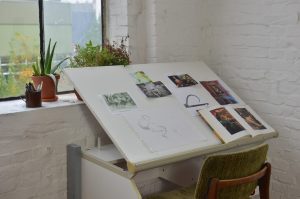Tripod Brixton,
Lambeth Town Hall,
1 Brixton Hill, London,
SW2 1RW
Hours: Monday to Friday, 8am – 7pm
Phone: 020 7580 7333
 The role of a Set Designer on a movie, television set or theatre production is to design and plan how the background of the scene will look. They are vital in setting the tone and creating a particular feel for the production, whether this is for an editorial shoot for Vogue or a West End show.
The role of a Set Designer on a movie, television set or theatre production is to design and plan how the background of the scene will look. They are vital in setting the tone and creating a particular feel for the production, whether this is for an editorial shoot for Vogue or a West End show.
After consulting with the rest of the creative team, the Set Designer makes rough sketches of the set and mood boards to get their visual ideas down on paper. This is a key step to ensure the look and feel of the scenic design reflects the director’s vison. Afterwards they will work with the rest of the production team and begin building the set.
What are some of their responsibilities?
• Budget and time management – they are responsible for managing the budget and the production timeline for the set production
• Discussing shooting requirements with directors and producers
• Communicate ideas with different talents on set – in order to ensure everything in the plan will align with reality
• Designing the set – designing and creating a plan for the set production
• Ensuring building of the set – typically managing a team of builders or engineers to build the set according to the Set Designer’s plans
Who does a Set Designer work alongside?
• Art Director
• Producer
• Director
• Set Decorator
• Propmaster
• Stage Designer
• Costume Designer
• Light Designer
• Carpenters
• Electricians
What makes a great Set Designer?
Having a natural ability for creativity and design, as well as a keen eye for detail. As well as initiative, excellent communication skills and ability to work well under pressure.
How to become a Set Designer?
• It is not essential to have a degree to become a Set Designer. However, it can provide you with a background in the industry and help you develop a network of contacts. While as a Set Designer degree may seem like the best option (https://www.ntu.ac.uk/course/art-and-design/ug/ba-hons-design-for-film-and-television) you can also do a degree in theatre design, performing arts, design for film and television, Graphic design, Interior design and Fine arts.
Networking
There are different ways to network –
• Attending events is a fantastic way to meet people in person
• LinkedIn – make connections!
• Facebook Pages – join a group and they will post jobs and advice!
• Talk to previous clients about extra work – sell yourself!
Work Experience
• Different Set Designers may offer work experience opportunities to build up your CV, enquire with them to see if they offer anything that may help!
• You could start as a Set Designer’s assistant, art department trainee, prop maker or a runner in film or TV and work your way up.
• You can take on a role as a set assistant – this enables you to get on set and see how it works – make sure to ask questions!
• Gaining budget and time management experience is also essential
Courses
• Companies such as ScreenSkills offer training with all sorts of roles – ScreenSkills have a great reputation among training centres and have been known to be recommended during university degrees for extra learning Here is some information on cameras! Opportunities in animation, children’s TV, film, games, high-end TV, television, VFX (visual effects) and immersive media – ScreenSkills https://www.screenskills.com/training-and-opportunities/?q=set%20designer
Portfolio
• A visual representation of your work helps to sell yourself – Behance or TheDots are great platforms to utilise
How do I book a Set Designer?
If you would like to enhance your project, here at Yellow Cat we have a wide network of talented Set Designers to suit all client needs. We have a rich talent pool for client’s to hire freelance Set Designers.
Tripod Brixton,
Lambeth Town Hall,
1 Brixton Hill, London,
SW2 1RW
Hours: Mon to Fri, 8am – 7pm
Phone: 020 7580 7333
Tripod Brixton,
Lambeth Town Hall,
1 Brixton Hill, London,
SW2 1RW
Hours: Monday to Friday, 8am – 7pm
Phone: 020 7580 7333